Pump Handbook by Igor J. Karassik, Joseph P. Messina, Paul Cooper, Charles C. Heald - 3rd edition
Подождите немного. Документ загружается.

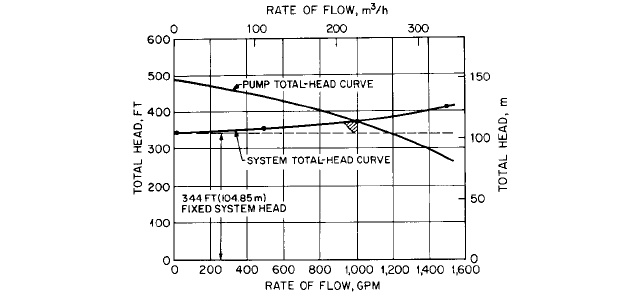
8.14 CHAPTER EIGHT
FIGURE 11 System total-head curve for Example 1
head for the same flow. When a pump is being purchased, it should be specified that the
pump head-capacity curve intersect the system-head curve at the desired flow rate. This
intersection should be at the pump’s best efficiency capacity or very close to it.
The system-head curve for Example 1 is shown in Figure 11. This assumes that the
suction and discharge liquid levels are 5 ft (1.5 m) below and 50 ft (15 m) above the datum
plane, respectively, and do not vary with flow. The pressure in the discharge tank is also
independent of flow and is 100 lb/in
3
(689.5 kPa) gage.These values are therefore fixed sys-
tem heads.The pipe and fitting losses are assumed to vary with flow as a square function.
The length of the pumping system is from point 1 to point 2. The difference in heads at
these points plus the frictional losses at various flow rates are the total system head and
the head required by a pump for the different flows. It is necessary to calculate the total
system head for only one flow rate
—
say, design
—
which in this example is 1000 gpm (227
m
3
/h). The total head at other flow conditions is the fixed system head plus the variable
system head multiplied by (gpm/1000)
2
(m
3
/h 227)
2
. If Example 1 is an existing system,
the total head may be calculated by using gages at the pump suction and discharge con-
nections. The total head measured will then be the head at the intersection of the pump
and system curves, as shown in Figure 11. In this example, a correctly purchased pump
would produce a total head of 372 ft (113 m) at the design flow of 1000 gpm (227 m
3
/h).
In systems that are open-ended and in which there is a decrease in elevation from inlet to
outlet, a portion of the system-head curve will be negative (Figure 12). In this example, the
pump is used to increase gravity flow. Without a pump in the system, the negative resistance,
or static head, is the driving head that moves the liquid through the system. Steady-state grav-
ity flow is sustained at the flow rate corresponding to zero total system head (negative static
head plus system resistance equals zero). If a flow is required at any rate greater than that
which gravity can produce, a pump is required to overcome the additional system resistance.
For additional information concerning the construction of system-head curves for flow
in branch lines, refer to Section 8.2.
VARIANTS IN PUMPING SYSTEMS ______________________________________
For a fixed set of conditions in a pumping system, there is just one total head for each flow
rate. Consequently, a centrifugal pump operating at a constant speed can deliver just one
flow. In practice, however, conditions in a system vary as a result of either controllable or
uncontrollable changes. Changes in the valve opening in the pump discharge or bypass
line, changes in the suction or discharge liquid level, changes in the pressures at these lev-
els, the aging of pipes, changes in the process, changes in the number of pumps pumping
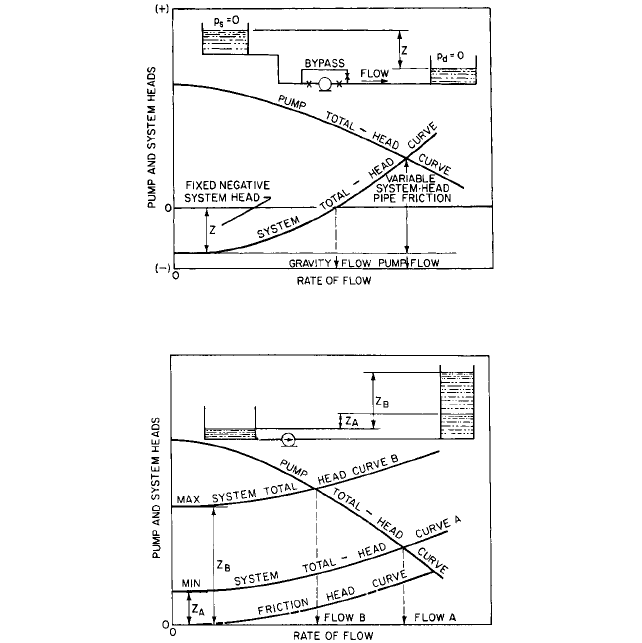
8.1 PUMPING SYSTEMS AND SYSTEM-HEAD CURRVES 8.15
FIGURE 12 Construction of system total-head curve to determine gravity flow and centrifugal pump flow
FIGURE 13 Construction of system total-head curves for a pumping system having variable static head
into a common header, changes in the size, length, or number of pipes are all examples of
either controllable or uncontrollable system changes. These changes in system conditions
alter the shape of the system-head curve and, in turn, affect pump flow.
Methods of constructing system-head curves and determining the resultant pump
flows for two of the more common of these variants are explained here.
Variable Static Head In a system where a pump is taking suction from one reservoir
and filling another, the capacity of a centrifugal pump will decrease with an increase in
static head. The system-head curve is constructed by plotting the variable system friction
head versus flow for the piping. To this is added the anticipated minimum and maximum
static heads (difference in discharge and suction levels). The resulting two curves are the
total system heads for each condition. The flow rate of the pump is the point of intersec-
tion of the pump head-capacity curve with either one of the latter two system-head curves
or with any intermediate system-head curve for other level conditions.A typical head ver-
sus flow curve for a varying static head system is shown in Figure 13.
If it is desired to maintain a constant pump flow for different static head conditions, the
pump speed can be varied to adjust for an increase or decrease in the total system head.
A typical variable-speed centrifugal pump operating in a varying static head system can
have a constant flow, as shown in Figure 14.
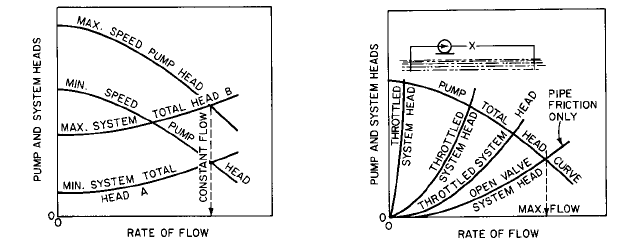
8.16 CHAPTER EIGHT
FIGURE 14 Varying centrifugal pump speed to
maintain constant flow for the different reservoir
levels shown in Figure 13
FIGURE 15 Construction of system total-head
curves for various valve openings
It is important to select a pump that will have its best efficiency within the operat-
ing range of the system and preferably at the condition at which the pump will operate
most often.
Variable System Resistance A valve or valves in the discharge line of a centrifugal
pump alter the variable frictional head portion of the total system-head curve and conse-
quently the pump flow. Figure 15, for example, illustrates the use of a discharge valve to
change the system head for the purpose of varying pump flow during a shop performance
test. The maximum flow is obtained with a completely open valve, and the only resistance
to flow is the friction in the piping, fittings, and flowmeter. A closed valve results in the
pump’s operating at shutoff conditions and produces maximum head. Any flow between
maximum and shutoff can be obtained by proper adjustment of the valve opening.
DIVIDING TOTAL HEAD AND SYSTEM-HEAD CURVES
FOR CENTRIFUGAL PUMPS IN SERIES__________________________________
Pump limitations or system component requirements may determine that two or more
pumps must be used in series. There are practical limitations as to the maximum head
that can be developed in a single pump, even if multistaged. When pumping through sev-
eral system components, there may be pressure limitations that prevent using a single
pump to develop all of the head required at the beginning of the system. If several pumps
are to be used in series, how should the total head be divided among them?
The sum of the total heads of the pumps must be equal to the required total system
head at the design flow. Although mathematically any division of the total head among the
pumps to be used is possible (at long as the sum of the pump heads is equal to the total
system head), the actual pressure required at various locations along the system flow path
determines how the pumping heads are to be divided. An energy or pressure gradient
should be drawn for the system. The number of pumps, their locations, and their total
heads should be selected to produce the desired pressures (or range of pressures) at criti-
cal locations along the system. In addition to considering the pressure loss through com-
ponents to overcome resistance to flow, consideration should also be given to the minimum
pressures required to prevent flashing in piping, cavitation at pump inlets, and so on, as
well as the maximum working pressures for different parts of the system.
If preferred, the total system can be divided into subsystems, one for each pump (or
group of pumps). The end of one subsystem and the beginning of another can be selected
anywhere between pumps in series because the pump total head will be unaffected by the
division line. Consequently, several system-head curves can be drawn for specification and
8.1 PUMPING SYSTEMS AND SYSTEM-HEAD CURRVES 8.17
purchasing purposes
—
for example, primary condensate pump system, secondary conden-
sate pump system, feed pump system, in a total power plant system.
TRANSIENTS IN SYSTEM HEADS _______________________________________
During the starting of a centrifugal pump and prior to the time normal flow is reached,
certain transient conditions can produce or require heads and consequently torques much
higher than design. In some cases, the selection of the driver and the pump must be based
on starting rather than normal flow conditions.
Low- and medium-specific-speed pumps of the radial- and mixed-flow types (less than
approximately 5000 specific speed, rpm, gpm, ft units) have favorable starting character-
istics. The pump head at shutoff is not significantly higher than that at normal flow, and
the shutoff torque is less than that at normal flow. High-specific-speed pumps of the mixed-
and axial-flow types (greater than approximately 5000 specific speed) develop relatively
high shutoff heads, and their shutoff torque is greater than that at normal flow. These
characteristics of high-specific-speed pumps require special attention during the starting
period. Characteristics of pumps of different specific speeds are shown in Figures 16a and
16b.
Starting Against a Closed Valve When any centrifugal pump is started against a
closed discharge valve, the pump head will be higher than normal. The shutoff head will
vary with pump specific speed. As shown in Figure 16a, the higher the specific speed, the
higher the shutoff head in percent of normal pump head. As a pump is accelerated from
rest to full speed against a closed valve, the head on the pump at any speed is equal to
the square of the ratio of the speed to the full speed times the shutoff head at full speed.
Therefore, during starting, the head will vary from point A to point E in Figure 17. Points
B, C, and D represent intermediate heads at intermediate speeds.The pump, the discharge
valve, and any intermediate piping must be designed for maximum head at point E.
Pumps requiring less shutoff power and torque than at normal flow condition are usu-
ally started against a closed discharge valve. To prevent backflow from a static discharge
head prior to starting, either a discharge shutoff valve, a check valve, or a broken siphon
is required. When pumps are operated in parallel and are connected to a common dis-
charge header that would permit flow from an operating pump to circulate back through
an idle pump, a discharge valve or check valve must be used.
Figure 18 is a typical characteristic curve for a low-specific-speed pump. Figure 19 illus-
trates the variation of torque with pump speed when the pump is started against a closed
discharge valve. The torque under shutoff conditions varies as the square of the ratio of
speeds, similar to the variation in shutoff head, and is shown as curve ABC. At zero speed,
the pump torque is not zero as a result of static friction in the pump hearings and stuffing
box or boxes.This static friction is greater than the sum of running friction and power input
to the impeller at very low speeds, which explains the dip in the pump torque curve between
0 and 10% speed. Also shown in Figure 19 is the speed-torque curve of a typical squirrel-
cage induction motor. Note that the difference between motor and pump torque is the excess
torque available to accelerate the pump from rest to full speed. During acceleration, the
pump shaft must transmit not only the pump torque (curve ABC) but also the excess torque
available in the motor. Therefore pump shaft torque follows the motor speed-torque curve
less the torque required to accelerate the mass inertia (WK
2
) of the motor’s rotor.
High-specific-speed pumps, especially propeller pumps, requiring more than normal
torque at shutoff are not normally started with a closed discharge valve because larger
and more expensive drivers would be required. These pumps will also produce relatively
high pressures in the pump and in the system between pump and discharge valve. Figure
20 is a typical characteristic curve for a high-specific-speed pump. Curve ABC of Figure 21
illustrates the variation of torque with speed when this pump is started against a closed
discharge valve. A typical speed-torque curve of a squirrel-cage induction motor sized for
normal pump torque is also shown. Note that the motor has insufficient torque to accel-
erate to full speed and would remain overloaded at point C until the discharge valve on the
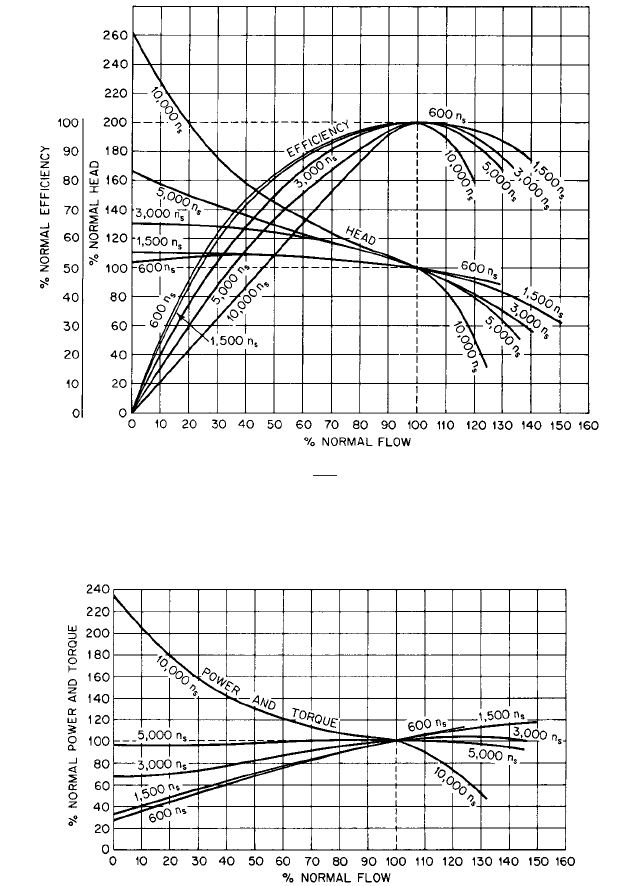
8.18 CHAPTER EIGHT
FIGURE 16A Approximate comparison of head and efficiency versus flow for impellers of different specific speeds
in single-stage volute pumps. Specific speed
To convert to other units using
rpm, m
3
/s, m: multiply by 0.01936; rpm, m
3
/h, m: multiply by l.163; rpm, L/s, m: multiply by 0.6123
To convert to the universal specific speed
s
(defined in Section 2.1) divide n
s
by 2733.
n
s
rpm 2gpm>TH in ft
3>4
FIGURE 16B Approximate comparison of power and torque versus flow for impellers of different specific speeds
in single-stage volute pumps
pump was opened.To avoid this situation, the discharge valve should be timed to open suf-
ficiently to keep the motor from overloading when the pump reaches full speed. To accom-
plish this timing, it may be necessary to start opening the valve in advance of energizing
the motor. Care should be taken not to start opening the discharge valve too soon because
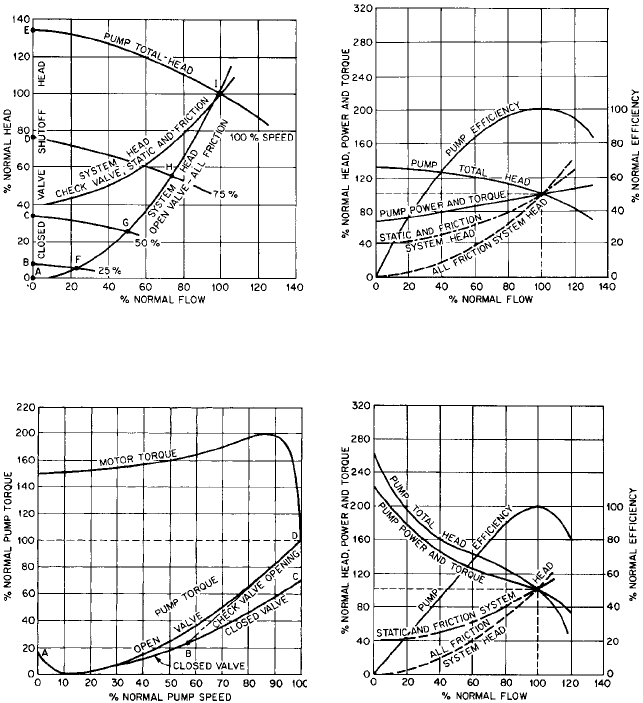
8.1 PUMPING SYSTEMS AND SYSTEM-HEAD CURRVES 8.19
FIGURE 17 Variation in head when a centrifugal
pump is started with a closed valve, an open valve, and
a check valve
FIGURE 18 Typical constant-speed characteristic
curves for a low-specific-speed pump
FIGURE 19 Variation of torque during start-up of a
loss-specific-speed pump with a closed valve, an open
valve, and a check valve. See Figure 18 for pump
characteristics.
FIGURE 20 Typical constant-speed characteristic
curves for a high-specific-speed pump
this would cause excessive reverse flow through the pump and require the motor to start
under adverse reverse-speed conditions. If the driver is a synchronous motor, additional
torque at pull-in speed is required, over and above that needed to overcome system head
and accelerate the pump and driver rotors from rest. At the critical pull-in point, sufficient
torque must be available to pull the load into synchronism in the prescribed time. A syn-
chronous motor is started on low-torque squirrel-cage windings prior to excitation of the
field windings at the pull-in speed. The low starting torque, the torque required at pull-in,
and possible voltage drop, which will lower the motor torque (varies as the square of the
voltage), must all be taken into consideration when selecting a synchronous motor to start
a high-specific-speed pump against a closed valve.
If a high-specific-speed pump is to be started against a closed discharge valve, high
starting torques can also be avoided by the use of a bypass valve (see Section 8.2) or by an
adjustable-blade pump.
1
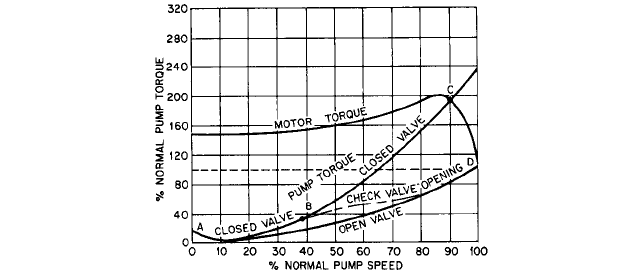
8.20 CHAPTER EIGHT
FIGURE 21 Variation of torque during start-up of a high-specific-speed pump with a closed valve, an open valve,
and a check valve. See Figure 20 for pump characteristics.
Starting Against a Check Valve A check valve can be used to prevent reverse flow from
static head or head from other pumps in the system. The check valve will open automat-
ically when the head from the pump exceeds system head. When a centrifugal pump is
started against a check valve, pump head and torque follow shutoff values until a speed
is reached at which shutoff head exceeds system head. As the valve opens, the pump head
continues to increase, and, at any flow, the head will be that necessary to overcome sys-
tem static head or head from other pumps, frictional head, valve head loss, and the iner-
tia of the liquid being pumped.
Figure 19, curve ABD, illustrates speed-torque variation when a low-specific-speed
pump is started against a check valve with static head and system friction as shown in
Figure 18. Figure 21, curve ABD, illustrates speed-torque variation for a high-specific-
speed pump started against a cheek valve with static head and system friction as shown
in Figure 20.The use of a quick-opening check valve with high-specific-speed pumps elim-
inates starting against higher than full-open valve shutoff heads and torques.
The speed-torque curves shown for the period during the acceleration of the liquid in
the system have been drawn with the assumption that the head required to accelerate
the liquid and overcome inertia is insignificant. Acceleration head is discussed in more
detail later.
Starting Against an Open Valve If a centrifugal pump is to take suction from a reser-
voir and discharge to another reservoir having the same liquid elevation or the same equiv-
alent total pressure, it can be started without a shutoff discharge valve or check valve. The
system-head curve is essentially all frictional plus the head required to accelerate the liq-
uid in the system during the starting period. Neglecting liquid inertia, the pump head
would not be greater than normal at and speed during the starting period, as shown in
curve AFGHI of Figure 17. Pump torque would not be greater than normal at any speed
during the starting period, as shown in Figures 19 and 21, curves AD. Pump head and
torque at any speed are equal to their values at normal condition times the square of the
ratio of the speed to full speed, whereas the capacity varies directly with this ratio.
Starting a Pump Running in Reverse When a centrifugal pump discharges against a
static head or into a common discharge header with other pumps and is then stopped, the
flow will reverse through the pump unless the discharge valve is closed or unless there is
a check valve in the system or a broken siphon in a siphon system. If the pump does not
have a nonreversing device, it will turn in the reverse direction. A pump that discharges
against a static head through a siphon system without a valve will have reverse flow and
speed when the siphon is being primed prior to starting.
Figures 22 and 23 illustrate typical reverse-speed-torque characteristics for a low- and
a high-specific-speed pump.When flow reverses through a pump and the driver offers very
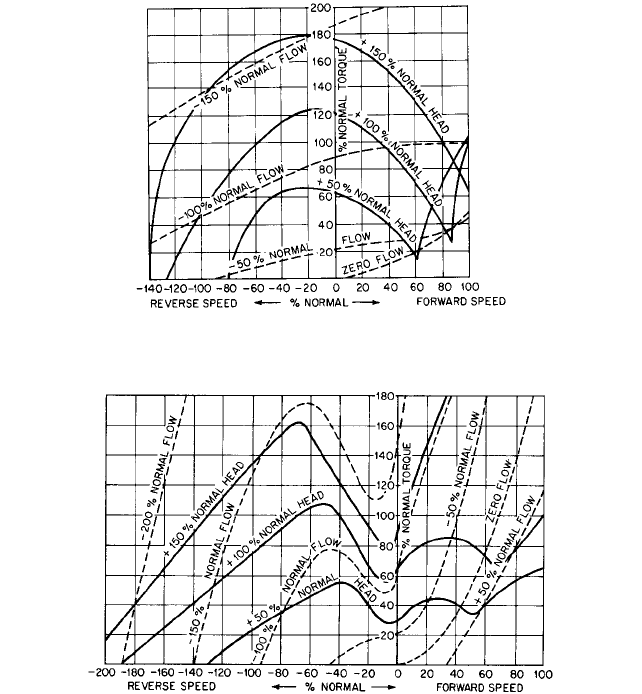
8.1 PUMPING SYSTEMS AND SYSTEM-HEAD CURRVES 8.21
FIGURE 22 Typical reverse-speed-torque characteristics of a low-specific-speed, radial-flow, double-suction pump
FIGURE 23 Typical reverse-speed-torque characteristics of a high-specific-speed, axial-flow, diffuser pump
little or no torque resistance, the pump will reach higher than normal forward speed in the
reverse direction. This runaway speed will increase with specific speed and system head.
Shown in Figures 22 and 23 are speed, torque, head, and flow, all expressed as a percent-
age of the pump design conditions for the normal forward speed.When a pump is running
in reverse as a turbine under no load, the head on the pump will be static head (or head
from other pumps) minus head loss as a result of friction due to the reverse flow.
If an attempt is made to start the pump while it is running in reverse, an electric motor
must apply positive torque to the pump while the motor is initially running in a negative
direction. Figures 22 and 23 show, for the two pumps, the torques required to decelerate,
momentarily stop, and then accelerate the pump to normal speed. If either of these pumps
were pumping into an all-static-head system, starting it in reverse would require over-
coming 100% normal head, and it can be seen that a torque in excess of normal would be
required by the driver while the driver is running in reverse. In addition to overcoming
positive head, the driver must add additional torque to the pump to change the direction
of the liquid. This could result in a prolonged starting time under higher than normal cur-
rent demand. Characteristics of the motor, pump, and system must be analyzed together
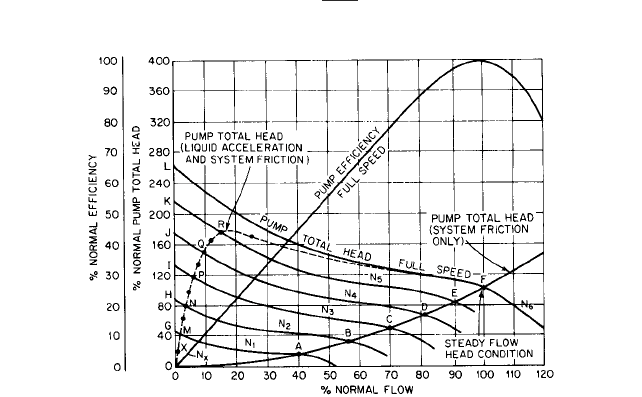
8.22 CHAPTER EIGHT
FIGURE 24 Transient system head as a result of liquid acceleration and system friction when a propeller pump
is started with an open valve
to determine actual operating conditions during this transient period. Starting torques
requiring running in reverse become less severe when the system head is partly or all fric-
tion head.
Inertial Head If the system contains an appreciable amount of liquid, the inertia of the
liquid mass could offer a significant resistance to any sudden change in velocity. Upon
starting a primed pump and system without a valve, all the liquid in the system must
accelerate from rest to a final condition of steady flow. Figure 24 illustrates a typical sys-
tem head resistance that could be produced by a propeller pump pumping through a fric-
tion system when accelerated from rest to full speed. If the pump were accelerated very
slowly, it would produce an all-friction resistance with zero liquid acceleration varying with
flow approaching curve OABCDEF. Individual points on this curve represent system resis-
tance at various constant pump speeds. If the pump were accelerated very rapidly, it would
produce a system resistance approaching curve OGHIJKL. This is a shutoff condition that
cannot be realized unless infinite driver torque is available. Individual points on this curve
represent a system resistance at various constant speeds with no flow, which is the same
as operating with a closed discharge valve. Curve LF represents the maximum total head
the pump can produce as a result of both system friction and inertia at 100% speed. Head
variation from L to F is a result of flow through the system, increasing at a decreasing
rate of acceleration and increasing friction to the normal operating point F, where all the
head is frictional. The actual total system-head resistance curve for any flow condition will
be, therefore, the sum of the frictional resistance in feet (meters) for that steady-flow rate
plus the inertial resistance, also expressed in feet (meters). The inertial resistance at any
flow is dependent on the mass of liquid and the instantaneous rate of change of velocity
at the flow condition. A typical total system resistance for a motor-driven propeller pump
is shown as OMNPQRF in Figure 24. For a particular pump and system, different driver-
speed-torque characteristics will result in a family of curves in the area OLF.
The added inertial system head produced momentarily when high-specific-speed
pumps are started is important when considering the duration of high driver torques and
currents, the pressure rise in the system, and the effect on the pump of operation at high
heads and low flows. The approximate acceleration head h
a
required to change the veloc-
ity of a mass of liquid at a uniform rate and cross section is
(10)h
a
L¢V
g¢t

8.1 PUMPING SYSTEMS AND SYSTEM-HEAD CURRVES 8.23
where L length of constant-cross-section conduit, ft (m)
V velocity change, ft/s (m/s)
g acceleration of gravity, 32.17 ft/s
2
(9.807 m/s
2
)
t time interval, s
To calculate the time to accelerate a centrifugal pump from rest or from some initial
speed to a final speed, and to estimate the pump head variation during this interim, a
trial-and-error solution may be used. Divide the speed change into several increments of
equal no-flow heads, such as OGHIKL in Figure 24. For the first incremental speed
change, point O to point N
1
, estimate the total system head, point M, between G and A.
Next estimate the total system head, point X, at the average speed for this first incre-
mental speed change. These points are shown in Figure 24. Calculate the time in seconds
for this incremental speed change to take place using the equation
in USCS units (11a)
where WK
2
total pump and motor rotor weight moment of inertia, W weight
(force), K radius of gyration, lb ft
2
N incremental speed change, rpm
T
D
motor torque at average speed, ft lb
T
p
pump torque at average speed, ft lb
in SI units (11b)
where MK
2
total pump and motor rotor mass moment of inertia, M weight
(mass), K radius of gyration, kg m
2
N incremental speed change, rpm
T
D
motor torque at average speed, N m
T
P
pump torque at average speed, N m
In SI units, when diameter of gyration D is used rather than radius of gyration K, and
MD
2
4MK
2
, then
(11c)
Calculate the acceleration head required to change the flow in the system from point
O to point M using Eq. 10 and time from Eq. 11. Add acceleration head to frictional head
at the assumed average flow, and if this value is correct, it will fall on the average pump
head-capacity curve, point X. Adjust points M and X until these assumed flows result in
the total acceleration and frictional heads agreeing with flow X at the average speed.
Repeat this procedure for other increments of speed change, adding incremental times to
get total accelerating time to bring the pump up to its final speed. Plot system head ver-
sus average flow for each incremental speed change during this transient period, as shown
in Figure 24.
Figures 25 and 26 illustrate how driver and pump torques can be determined from
their respective speed-torque curves. Figure 25 is a family of curves that represents the
torques required to produce flow against different heads without acceleration of the liq-
uid or pump for the various speeds selected. Pump torque for any reduced speed can be
calculated from the full-speed curve using the relation that torque varies as the second
power and flow varies as the first power of the speed ratio. Point X is the torque at the
average speed and the trial average flow during the first incremental speed change,
¢t
MD
2
¢N
38.21T
D
T
P
2
¢t
MK
2
¢N
9.551T
D
T
P
2
¢t
WK
2
¢N
3071T
D
T
P
2
